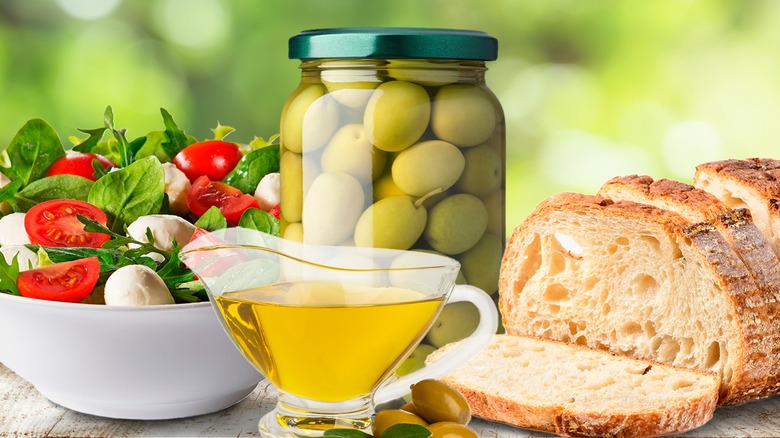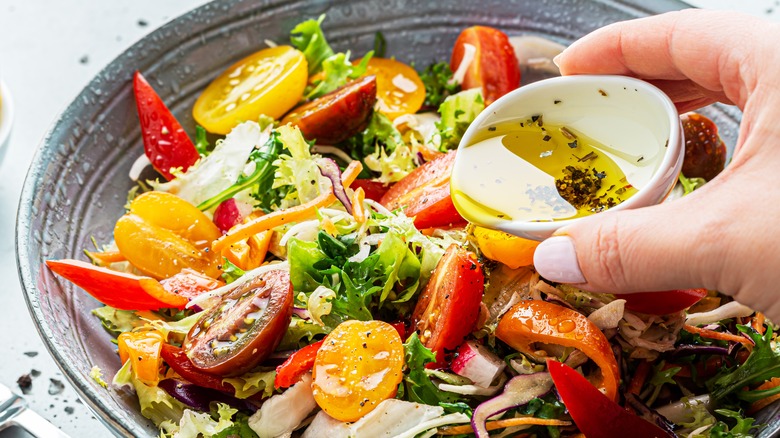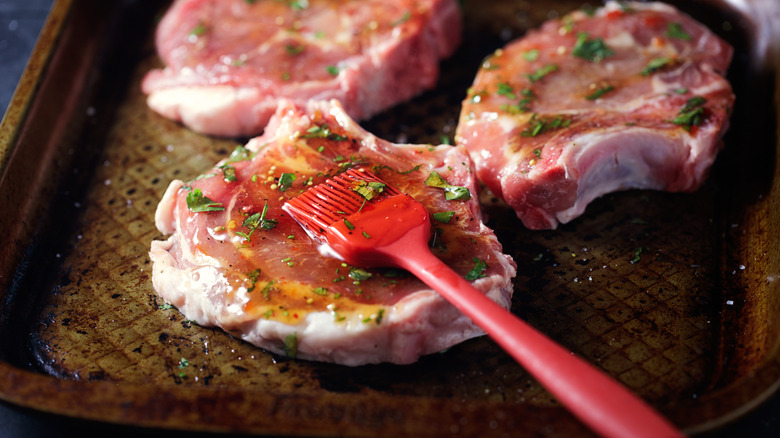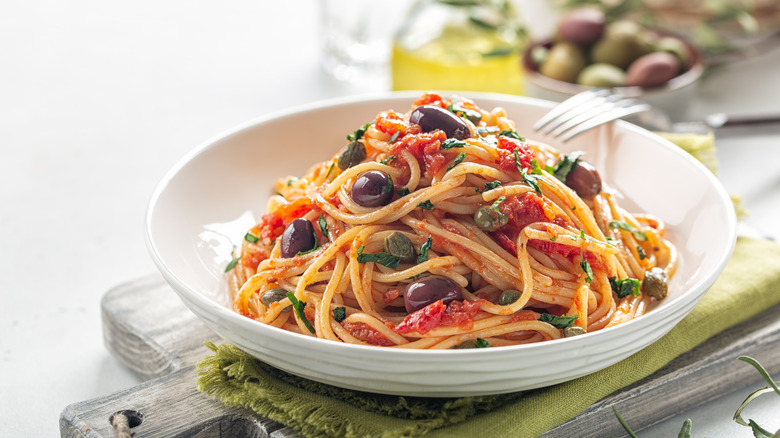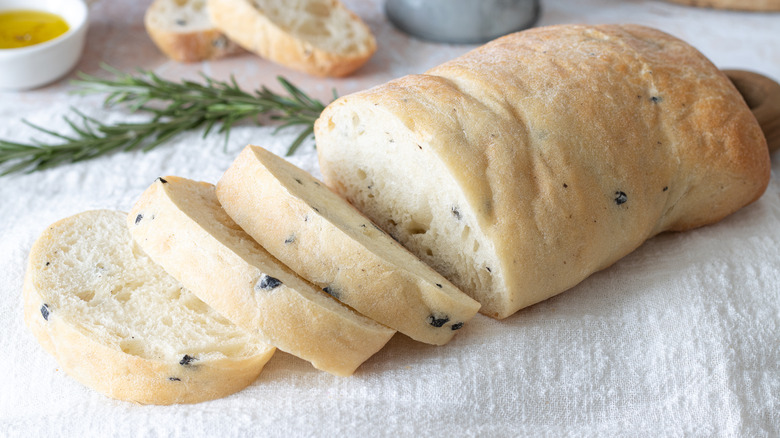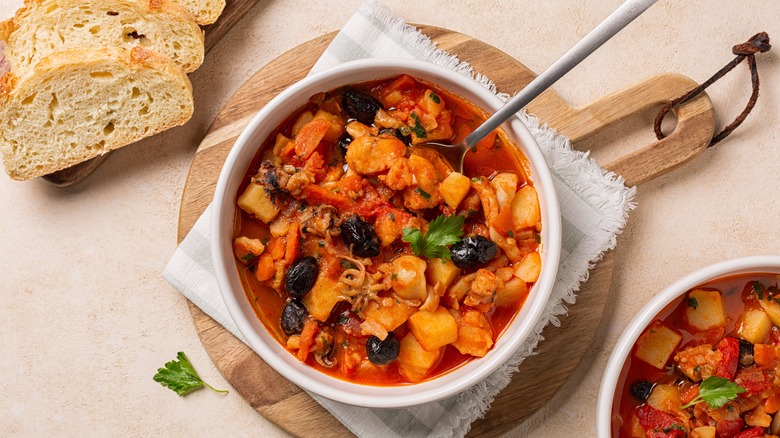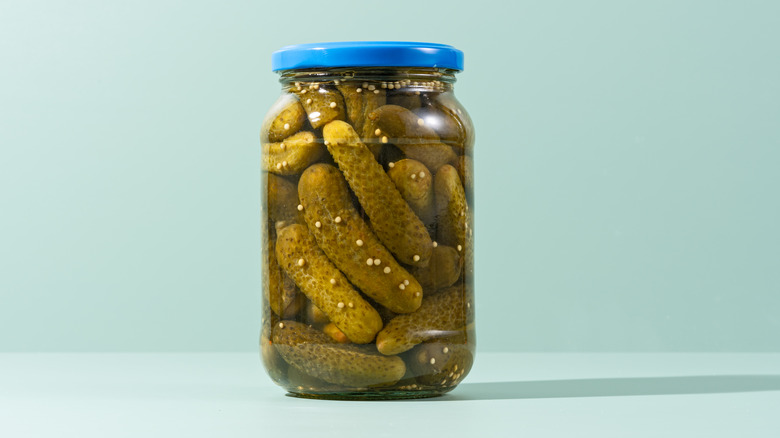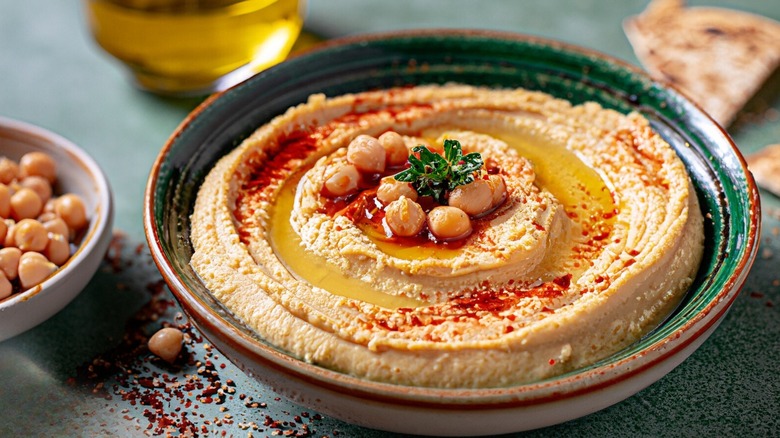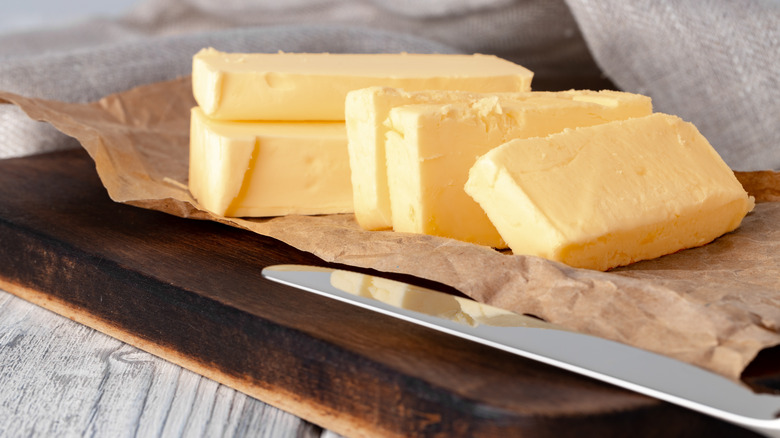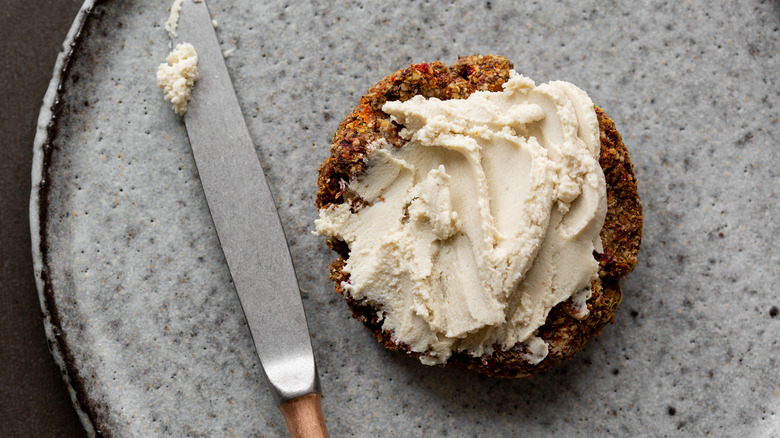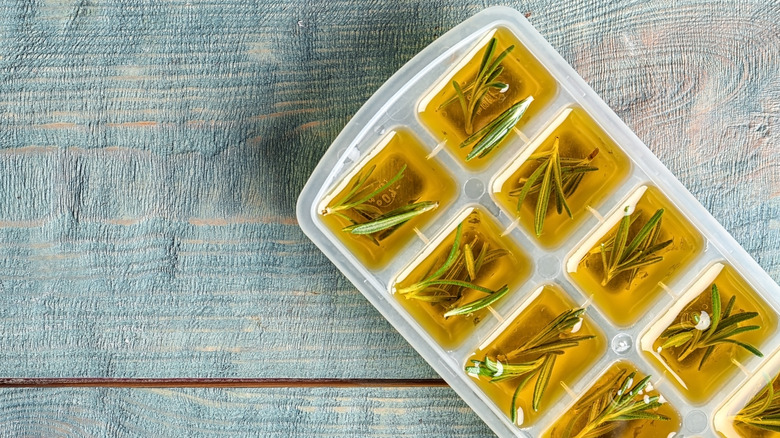12 Ways To Use The Juice From A Jar Of Olives
When you finish a jar of olives, your instinct may be to dump out the remaining liquid inside and throw away the container. However, when no olives remain in the jar, this doesn't mean that the product is done with. To the contrary, the liquid that remains — consisting typically of water, vinegar, and salt, along with the olives' deliciously tangy taste — is in fact something of a culinary treasure. Incredibly tasty and wholly versatile, this punchy liquid has a vast array of applications, adding depth and flavor to everything from cocktails to couscous.
Indeed, olive juice lends itself well to a wide range of ingredients and dishes, complementing sweet and slightly acidic flavors like tomato-based sauces, as well as enhancing light and warming spices in Mediterranean cuisine. The liquid's consistency also makes it highly adaptable, meaning there truly is no reason for a single drop to go to waste.
Even if you are not looking to create something with a bold and distinctive olive taste, this handy liquid serves as an excellent umami booster without overpowering more delicate ingredients, although it can be embraced for its signature flavor if you desire. So, if you are looking to elevate your midweek meals or add a touch of class to your cocktail evenings, keep that olive juice away from the drain and hold onto it to provide an instant upgrade to your kitchen favorites.
Add olive-jar juice to cocktails
If ever proof was needed that olives and cocktails are a perfect match, the classic and elegant martini provides it. The dirty martini, a popular variation made by adding olive brine into the mix, arguably takes this drink to the next level, embracing olives as an appetizing garnish along with the juice they come in. As such, there is no easier way to put your leftover olive juice to good use than by making a dirty martini with it, for a simple but sophisticated drink that packs a flavorful punch.
However, there are many other cocktails beyond martinis that are elevated by the salty tang of olive juice. Bloody Mary cocktails, for example, are full of umami-rich ingredients like tomato juice and Worcestershire sauce, which are perfectly complemented by the unique taste of olive brine. Likewise, margaritas are given a boost by the inclusion of olive juice for a refreshing twist that blends seamlessly with existing ingredients, and a splash of the liquid certainly won't feel out of place in a vodka tonic. To imbue your cocktails with the signature taste of olives, simply combine the juice with your other liquid ingredients before shaking everything up, adjusting quantities according to preference.
Turn it into a salad dressing
Thanks to its consistency, olive juice makes an excellent base for a salad dressing. Although its salty and tangy taste makes it perfectly suitable for drizzling over salad on its own, you can whip up a vinaigrette using olive brine by combining it with garlic, mustard, and lemon juice. Further additions such as herbs like thyme and rosemary are optional extras that provide even more flavor for a salad that packs a punch.
Olive-jar juice is not limited to being used for vinaigrettes. You can also combine it with ingredients such as Greek yogurt or mayonnaise for a thicker, more luxurious dressing with a briny note. Such dressings lend themselves well to an array of salads, perking them up with a touch of tartness, but Mediterranean-style salads — featuring ingredients like tomatoes, feta cheese, and whole olives — will harmonize perfectly with its distinct taste.
You'll likely want to sample as you go when making a dressing with olive juice, as you might find that the result can come out saltier or stronger than you are used to. Start with a moderately small amount, and continue to whisk the olive liquid into the dressing according to preference, adjusting other seasonings and liquid ingredients accordingly.
Make olive-jar juice into a tasty marinade
From pork chops to sirloin steak, most meats are elevated by the addition of a flavorful marinade. Made by combining liquid with various herbs and spices, soaking your meats in a solution before cooking can ensure delicious results. Olive-jar juice makes an excellent base for a marinade, offering its unique salty and briny taste while also remaining highly versatile. Mixed with soy sauce and brown sugar, olive brine could make a rich and tangy coating for pork or beef — and seafood fares particularly well when coated in olive-jar juice, garlic, and lemon juice.
Not only is olive brine great for soaking your meats to provide them with flavor, it also ensures that they stay juicy. Using a salty and acidic liquid to marinade meat is helpful for keeping it moist and tender as it cooks, which is particularly useful for cuts like lean steaks and chicken breasts, both of which have a propensity to become dry and chewy. It turns out that using olive brine is the key to juicy and tangy chicken. Its salt content and acidity help to tenderize the chicken — hindering the chance of it becoming tough during cooking — and its subtle sweetness keeps things tender and fresh. With no extra ingredients required, this is a simple but surefire way to ensure that you're making the most of your meat.
Perk up your pasta with it
Pasta and olives go hand in hand, so your leftover olive brine will by no means be out of place when it's added to your pasta dish. Olive juice can be added to many pasta dishes that you may already have in your repertoire, providing an easy but noticeable way to elevate them. The brine can blend seamlessly into pesto for a bold and interesting twist, or add depth to tomato-based sauces by balancing their sweetness and acidity. Furthermore, olive brine will upgrade store-bought pasta sauce — including creamier, richer sauces such as Alfredo or carbonara, as the liquid helps to cut through some of the richness for a slightly lighter feel.
For anyone looking to prepare a pasta dinner without stocking up on multiple ingredients, olive juice also comes in handy for making Neapolitan aglio e olio. This humble but tasty dish is traditionally made using just garlic, salt, and olive oil, although red pepper flakes and Parmesan cheese are common additions, allowing for the signature tastes of the star ingredients to truly shine. You can substitute some of the olive oil in aglio e olio for olive brine, which will provide the same luscious taste along with a little extra saltiness and sourness that works beautifully alongside garlic, or simply drizzle a tablespoon or two over the pasta and stir it in before serving for an extra bit of oomph.
Incorporate olive brine into homemade bread
There are few better appetizers than warm, crusty bread dunked into rich and floral olive oil. The combination of sharp olives and fluffy, toasted bread is hard to beat — but it can be elevated. In fact, you can take this perfect pairing to the next level by incorporating that delicious olive taste into the bread before it bakes by adding the brine to your dough. Indeed, in the same way that pickle juice can be added to a homemade bread recipe to give it delicious sharpness, the juice from your olive jar can be used to replace some of the water in your mix to produce a seriously tasty and moist loaf.
Simply combine olive juice with a little warm water, before gradually adding the combination into your dry ingredients until you have formed a dough. If you still have a few olives with your juice, adding them diced into the dough makes an excellent ingredient for an even stronger flavor and an enticing texture. Leave the dough to prove before baking, and you'll end up with crusty, fluffy bread that is bursting with sweet and sour flavors, perfect for savory sandwiches, mopping up juices from soups and stews, or simply enjoying as is, warm out of the oven.
Add depth to soups and stews
Adding olive brine to savory soups and stews is a great way to impart extra flavor, acidity, and complexity, and the addition works well for diverse recipes. The umami tastes of broth-based soups, such as chicken noodle soup or a hearty minestrone, are intensified by the salty tang of olive-jar juice. Meanwhile, a splash of brine in a thicker, creamy soup may help to balance out some of the richness, thanks to the juice's acidity.
Just a teaspoon or two can help to deepen the existing flavors of your liquid-based dishes, without the olive taste overpowering more delicate and nuanced ingredients. However, if you particularly enjoy the taste of olives and their juice, you can certainly lean into this by incorporating it into dishes where its bold tang will be at the heart of the dish. Try adding the brine to chicken cacciatore, which is traditionally served with a scattering of black olives, or to a hearty Moroccan chickpea stew recipe, where it will enhance the warmth and sweet spiciness of cumin and cinnamon.
Turn olive-jar juice into a pickling solution
Pickling your vegetables is an excellent means of enjoying them in a whole new way, providing them with an appetizing sharpness. With a quick-pickling process, you can enjoy your preserved goods sooner, and using your leftover olive brine as a pickling solution makes this process even speedier, not to mention incredibly easy. Since olive juice typically consists of water, vinegar, and salt, it lends itself perfectly to sousing vegetables and eggs, given that pickling brine itself is essentially just water, vinegar, and salt.
Depending on the ingredients of your olive juice, you may be able to use it immediately as a pickling solution. Simply add your chosen ingredients to the liquid, refasten the lid on the jar, and leave it in the fridge to soak. However, you may need to adjust some of the quantities of vinegar and water, or add a little sugar to balance out the sourness if you so desire, to ensure a successful pickling solution.
Remember that you're aiming for a ratio of roughly 3 parts water to 1 part vinegar, but add a little more of either liquid to your olive juice if these proportions are not quite right, or the taste is not to your liking. Once you have your brine ready, you can get creative with tasty additions for a more personalized approach, adding optional extras such as garlic or fiery peppercorns for intensified flavor, or fresh chilies for a spicier take.
Stir olive brine into dips
Olive-jar juice's versatility, paired with its light consistency, can make it an ideal addition to numerous dips and spreads. Hummus, in particular, is given a tasty boost by the inclusion of tangy olives; a simple drizzle of olive oil will make your hummus look and taste better. The earthy and nutty flavor of chickpeas is complemented perfectly by the sharpness of olive brine, for a more complex and nuanced dip. Likewise, aioli — with its own punchy, garlicky taste — is also given an upgrade through the inclusion of olive juice, granting it a tartness that is perfect for dunking just about anything.
Tomato-based dips and condiments, like salsa and ketchup, also benefit from the depth that olive juice provides, providing a unique way to top your burgers or nachos. To imbue these condiments with olive juice, simply stir in a teaspoon at a time until they reach your desired taste, adding sugar or salt as required, alongside a potential squeeze of lemon to help balance out any excess acidity from the brine.
Cook grains in it
There's no reason why your grains have to be plain. Though the versatility of a neutral side dish can be useful for pairing with an array of entrées, imparting flavor specifically into your rice or quinoa — as well as pulses like lentils — can result in a tastier meal. A simple, easy, and commonly overlooked way to do this is to cook your grains in a liquid other than water, and olive-jar juice proves itself to be a top choice. Its consistency means that it is absorbed by grains very similarly to water, so it won't drastically impact the texture of your dish when used as a substitute. It will, however, provide a significant boost to the taste of your grains, giving you a truly flavorful result.
Though you may not want to substitute all of your water for olive juice, as this may overpower the subtle nuttiness of ingredients like white rice or fluffy couscous, swapping out some of the plain liquid in favor of bold and punchy olive brine is a simple way to create Mediterranean side dishes. Such sides are excellent for serving alongside tender and juicy roasted meats such as lamb chops or a saucy steak — but as powerhouses of nuanced flavor, brine-infused grains are equally worthy of taking center stage.
Infuse your butter with olive brine
There are many ways to add flavor to butter that turn it into an entirely new spread, and olive brine is undoubtedly amongst the best add-ins for a truly tasty butter. Great for slathering on top of crusty bread in place of an olive oil dip, butter that has been mixed with olive-jar juice takes on a whole new dimension of flavor, serving not just as a condiment to complement other ingredients, but as a delicious spread in its own right. Swap out your regular butter for olive-juice butter when making a sandwich for a simple but noticeable upgrade, or baste your meat and seafood in it to imbue them with buttery, tangy goodness.
It is actually incredibly easy to make compound butter, so using up your leftover olive juice in this way is a great choice if you are strapped for time. Simply blitz together slightly softened butter with the olive juice using a hand mixer, until the juice is completely absorbed and combined with the butter. Add in the juice gradually as you mix, tasting often to avoid overpowering the butter. The finished product can then be refrigerated and used whenever you want to add a subtle upgrade to anything you would normally cook or serve with butter.
Give vegan cheese the tang it needs
The growing popularity of plant-based diets means that vegan cheeses are relatively easy to find nowadays, but it's also still useful and fun to make your own vegan cheese at home. Many vegan cheeses are made with soy, or nuts that lend a creamy texture — such as cashews or macadamias, both of which have a rich flavor and luxurious consistency. However, there's one crucial ingredient which takes vegan cheese from acceptable to exceptional, and that's olive brine. Undoubtedly, olive-jar juice is something of a hidden gem when it comes to making vegan cheese, as its signature salty and sour taste provides a tang that mimics the aged taste associated with conventional dairy cheeses.
Olive juice is particularly useful if you are looking to create plant-based versions of tart, tangy cheeses such as feta, but it also works well to recreate sharp cheeses like cheddar, providing the brightness and intensity that can sometimes feel lacking in vegan versions. You can easily incorporate olive brine into vegan cheese to elevate it, adding around 2 tablespoons (or more, depending on the quantities of your other ingredients), and blending it together with the rest of your ingredients before forming the cheese. The finished result serves as a brilliant substitute for feta in colorful, leafy salads, or when crumbled over pasta dishes for added dimensions of taste and texture.
Freeze olive brine into ice cubes
If you have sufficient inspiration or specific ideas of what to do with your leftover olive juice, but lack the time or resources to imminently carry out such plans, you can look ahead and simply freeze the liquid into cubes. Indeed, there's no reason why ice cubes have to consist of just water — freezing your olive brine into individual cubes is an ingenious way to preserve the liquid and have a helping ready whenever you want to add a boost to recipes.
One or two cubes can be added to sauces or stews, where they will melt and impart the brine's signature taste for a quick upgrade — or consider using these instead of regular ice cubes in cocktails for added umami richness. Bloody Mary drinks will maintain their rich savory notes when served with olive juice ice cubes, which do not pose the risk of diluting the drink as they melt, and instead imbue it with extra flavor. Meanwhile, a martini can be made dirty with the simple addition of one olive-juice cube. Whatever you choose to do with the cubes, preparing them in this way is a smart way of extending their usage, and also freeing up space by decanting them from an empty jar into neater ice cube trays.
